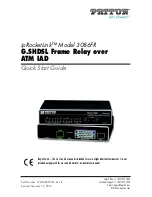
C-9
Cisco MGX 8850 (PXM1E/PXM45), Cisco MGX 8950, Cisco MGX 8830, and Cisco MGX 8880 Configuration Guide
Release 5.0.10, OL-3845-01 Rev. B0, August 16, 2004
Appendix C Supporting and Using Additional CLI Access Options
Setting Up Dial-Up Connections
Note
Use a subnet mask that is different from the network mask used for LAN port communications.
If you use the same subnet for both ATM and LAN port communications, there will be two
entries for the same subnet in the routing table and all egress IP communications will take place
through the atm0 port.
Tip
Cisco recommends that you use the same subnet for all atm0 IP addresses defined on all
MGX 8850 switches. This practice simplifies router configuration.
Note
There are other options for the ipifconfig command, and you can set one or more options
simultaneously. Any options you do not define in a command remain unchanged. For more
information on this command, refer to the Cisco MGX 8850 (PXM45/PXM1E), Cisco MGX
8950, Cisco MGX 8830, and Cisco MGX 8880 Command Reference, Release 5.
Step 4
To verify the IP address you configured, enter the following command:
mgx8850a.7.PXM.a>
dspipif atm0
Step 5
Make a note of the IP address defined for the atm0 interface. This is the IP address switch administrators
must use to manage the switch.
Step 6
Configure the switch AESA for IP connectivity by entering the following command:
mgx8850a.7.PXM.a>
svcifconfig atm0 local
<
ATM_Addr
>
Replace ATM_Addr with the AESA for the interface. This address must conform to the address plan for
the switch.
Step 7
Define the AESA for the ATM router by entering the following command:
mgx8850a.7.PXM.a>
svcifconfig atm0 router
<
ATM_Addr
>
Replace <ATM_Addr> with the AESA for the interface. This address must conform to the address plan
for the switch.
Step 8
To verify the ATM addresses you configured, enter the following command:
mgx8850a.7.PXM.a>
dspsvcif
Step 9
If you have not already done so, configure the PNNI controller as described in the “
” section in
Chapter 2, “Configuring General Switch Features.”
Step 10
Configure the ATM line to the ATM router as described in the “
” section in
Chapter 3, “Provisioning PXM1E Communication Links.”
The line configuration should specify a UNI port, SCT 6, and a partition that supports at least 20
connections.
Step 11
To verify connectivity to directly attached ATM routers, enter the dsppnsysaddr command.
The ATM addresses of directly attached ATM routers should appear in the list the switch displays. To
display an ATM address for a remote router, you need to establish a CLI session on the remote switch
and enter the dsppnsysaddr command.
Step 12
To check the status of ports leading to directly-attached ATM routers, enter the dsppnports command.
















































